Workforce diversity efforts are notably increasing in the corporate environment. Companies worldwide have increased their diversity spend, creating a diversity and inclusion market that was estimated to be worth £6.5 billion in 2020. As companies increase their diversity budget, the market could reach £13.1 billion by 2026.
Despite billions of pounds going into diversity, equity and inclusion (DEI), plenty of businesses are still missing the target. Some continue to struggle to find and hire diverse talent. Others are unable to retain their diverse talent. Many times, a lack of DEI progress can be attributed to a company taking a check-the-box approach to DEI rather than working to change long-held norms that hold back diversity. They might have a strong DEI statement or talent management campaign but lack the inclusion efforts and accountability that ensure what’s said reflects what employees experience.
What other mistakes are organisations making that limit diversity growth and success? Here are three common errors combined with tips for making diversity a company pillar rather than a talking point.
Mistake No. 1: Forgetting The People-Driven Purpose Of DEI
The companies that are winning with DEI are deeply connected to their purpose as a business and weave diversity into that company fabric. Those that fail are often struggling because their diversity efforts are tactical moves rather than purposeful workforce evolutions.
Some businesses, for example, will change their diversity hiring approach to avoid litigation or make superficial changes to compete for contracts with specific diversity requirements. Box-checking exercises do not drive positive workforce change. Instead, employees recognise the indifference behind the companies playing lip service to DEI, further eroding employee engagement and retention.
Purpose-driven businesses, on the other hand, that unite their diversity goals and programmes to the overarching company mission have a powerful advantage. While bridging company purpose and diversity efforts can be challenging, here are a few ideas to get started:
- Get genuine commitment from the top. Business leaders are responsible for shaping and communicating the company’s purpose to all audiences—employees, customers, prospects, partners, etc. When they do the job of connecting the company’s purpose to diversity efforts, it elevates diversity work and goals. It’s not simply something the business says, it’s part of how the company operates and grows.
- Bring DEI efforts and stories to life. To connect business purpose and diversity efforts, HR needs to bring DEI efforts and stories to life. Share examples of how and where DEI programs are making an impact with engaging case studies and profiles. Share them in intentional ways that reach everyone—in town halls, on social media, at company events and through company newsletters. Employees who are regularly informed of the positive results of diversity programs and invited into the conversation will become advocates who see DEI as part of company culture.
- Set representation goals. Work with leadership and employees to set representation goals, especially in leadership and other critical areas. If the business is struggling to get enough people of varied ethnic backgounds or women into management or leadership roles, setting a goal that the entire company can focus on makes purposeful change a part of everyone’s job.
Mistake No. 2: Concentrating Only On The Talent Pipeline Versus Inside Talent
Focusing diversity efforts only on incoming talent is another mistake businesses make. They identify diversity hiring goals that will bring new talent in, but they forget the experience of employees inside the business. How are employee retention and development efforts supporting DEI? Are diverse employees feeling included in the culture and in growth opportunities? Are they contributing feedback for continuous improvement?
Taking the time to listen to employees through surveys, town halls and even one-on-one meetings is critical to building a strong diversity foundation. Based on our experience working with companies to build a truly dynamic approach to diversity that cascades down from leadership and rises up from the workforce, steps may include:
- Providing training tools to ensure everyone understands what DEI is, why it matters and your approach to DEI.
- Listening and gathering insight from diverse talent across the business to ensure the entire organization understands its diverse employees and their experiences.
- Forming, supporting and investing in employee resource groups (ERGs), as well as giving employees the dedicated time at work to participate in those groups.
- Requiring everyone, at every level in the business, to have one diversity goal of their choosing that helps improve company diversity efforts.
Mistake No. 3: Thinking Every Effort Needs To Directly Connect To Revenue Or Recruiting
If you try to link every DEI effort to a revenue or recruiting target, your business will miss plenty of other opportunities to establish business practices that deliver long-term DEI value. Look for ways to incorporate DEI into how the business operates, such as:
- Offer paid holidays of choice. Rather than management choosing all the holidays the company takes off, allow employees a handful of paid holidays that they can apply to the celebrations and events that matter most to their culture, religion and/or family.
- Spend with diversity in mind. Commit to procuring a key segment of company services and goods from diverse suppliers.
- Sponsor outreach. Give employees time to re-invest their skills into the local community with company-sponsored volunteer time. Encourage employees to spend volunteer hours among diverse communities and help the organisation build new ties with underserved and underrepresented groups.
Ultimately, embracing and cultivating diversity is a choice for businesses. A business can wear a badge and check a box for striving to increase its diversity—or a business can embrace DEI from the top down and the bottom up to gain benefits like greater retention, healthier company culture and a workforce that values differences. The contrast between the two approaches couldn’t be more clear.
Original Blog Source can be found here
If you are currently looking to employ global talent, or need support or advice in executing your Global Mobility strategy give us a call. We have years of experience in the field, and can fully support you at every stage of your Global talent management process.
Our immigration updates are for informational purposes only and are not a substitute for legal or scenario-specific advice. Furthermore, it is important to note that immigration announcements are subject to sudden and unexpected changes. If you have any further questions, or want more info about our services, please contact us on info@etesearch.com or call 01245 939188

